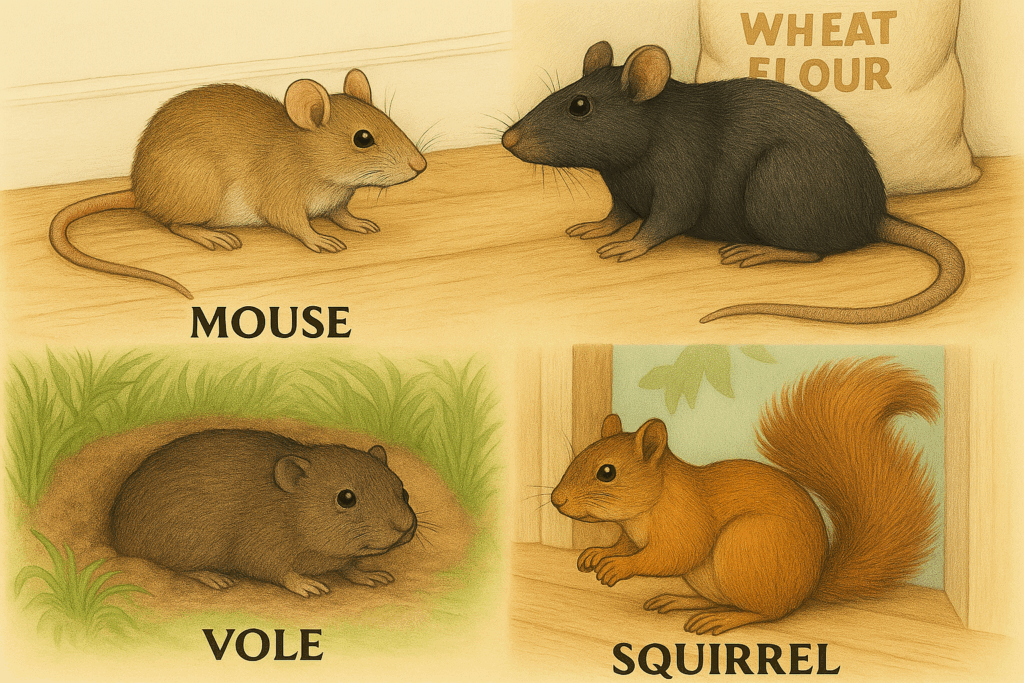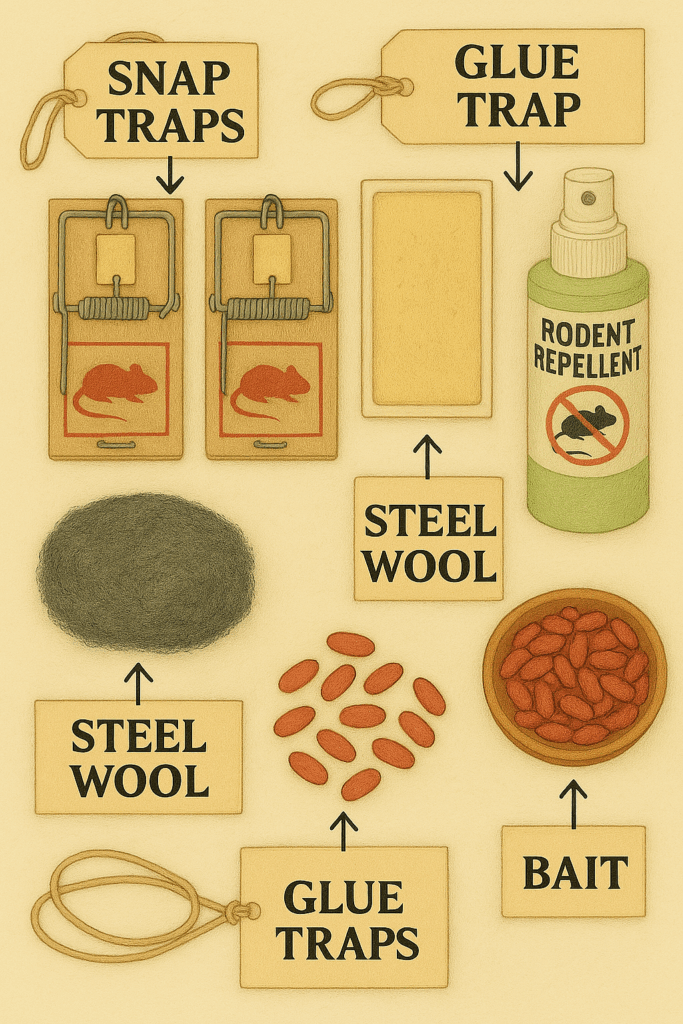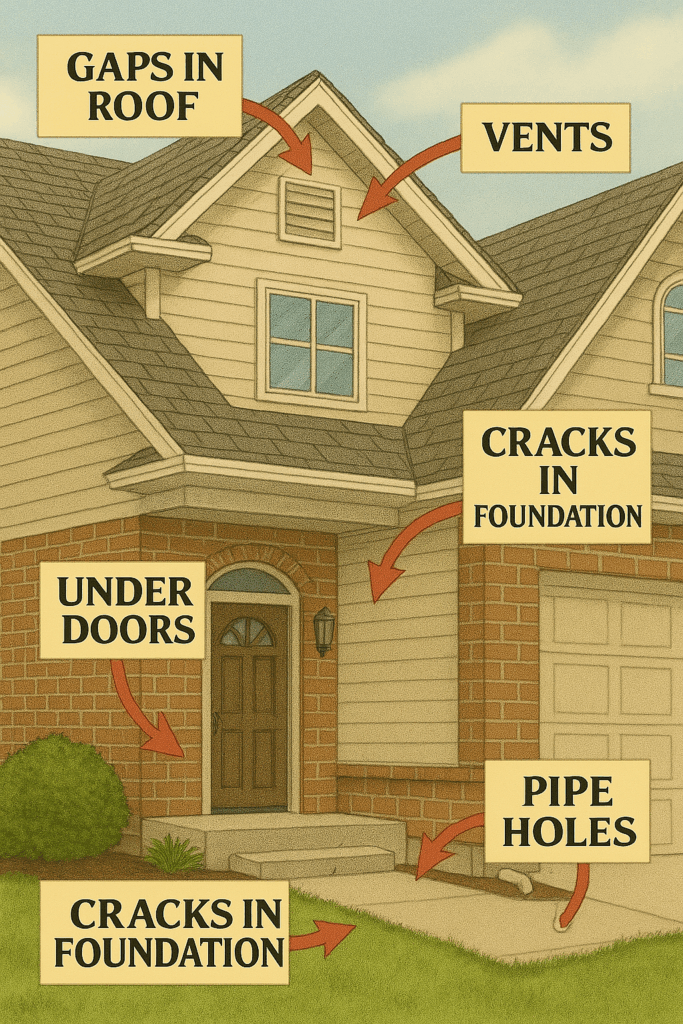
1. Understanding the Rodent Problem in Canada
Rodents Control Canada are a growing concern—especially during those chilly months when they seek warmth and shelter. From the bustling cities of Toronto and Vancouver to the quiet corners of Nova Scotia, rodents don’t discriminate. Let’s break it down:
What Types of Rodents Are Common in Canada?
Canada is home to a few “celebrity rodents” you’ll likely run into:
- House Mice: Small, sneaky, and surprisingly athletic.
- Norway Rats: Bigger, more aggressive, and excellent diggers.
- Roof Rats: Love attics and trees.
- Deer Mice: Common in rural areas—often carriers of hantavirus.

Seasonal Rodent Activity Patterns
Rodents are like seasonal tourists—they love visiting homes in fall and winter. Here’s a simple breakdown:
- Spring/Summer: Active outdoors, breeding season.
- Fall/Winter: Moving indoors to stay warm and find food.
🕵️♀️ Fun Fact: A single pair of mice can produce over 60 offspring in a year!
Why Rodents Are a Problem
Here’s why they’re more than just annoying:
- Health Hazards: Rodents carry diseases like leptospirosis and hantavirus.
- Home Damage: They chew on wires, insulation, and even furniture.
- Fire Risks: Rodent-chewed wires = potential electrical fires.
How Fast Do Rodent Infestations Grow?
Let’s just say… faster than your Netflix queue.
- One mouse becomes dozens in a month.
- Rats can birth up to 12 pups per litter, and that happens 6+ times a year.
Real-Life Example:
A homeowner in Ottawa ignored scratching sounds for a week. Result? A family of 14 rats under the kitchen cabinets. Repairs cost over $2,000.
2. Identifying Signs of Rodents Control Canada in Your Home
You can’t fix what you can’t see. Let’s help you spot them before they take over.
Physical Evidence
Rodents leave calling cards:
- Droppings (small and pellet-shaped)
- Chewed food packages
- Gnawed wires or wood
- Grease marks on walls
Example List:
- Droppings near food or in drawers
- Chewed cereal boxes or pet food bags
- Scratches or gnaw marks under sinks
- Shredded paper or fabric used for nesting
Sounds and Smells That Indicate Rodent Presence
It’s not just what you see. It’s also what you hear and smell:
- Scratching sounds in the walls or ceiling
- Squeaking at night
- A musty, ammonia-like smell
Nesting Habits and Hidden Entry Points
Rodents are privacy lovers. They build nests:
- Behind appliances
- Inside wall voids
- In attics and basements
And they enter through:
- Holes as small as a dime (for mice)
- Open vents or damaged screens
- Gaps around pipes or utility lines
When Should You Worry?
One rodent is too many. If you see:
- Fresh droppings every day
- Active rodents during the daytime
- Strange pet behavior (barking at walls)
…it’s go-time.
3. Preventing a Rodent Infestation
The best way to deal with rodents? Don’t let them move in at all. Prevention is the secret sauce to a rodent-free home. Here’s how to keep them out for good.
Sealing Entry Points Effectively
Rodents are escape artists—and entry artists too. They can squeeze through holes as small as:
- 1/4 inch for mice
- 1/2 inch for rats
To block them out:
- Use steel wool or hardware cloth to fill small holes
- Apply caulk or expanding foam around pipes and wires
- Install door sweeps under doors
- Fix cracks in foundations and gaps in siding
🔍 Pro Tip: Pay extra attention to your basement, garage, and roof vents.
Safe Food Storage and Trash Disposal
Your kitchen is a rodent buffet if you’re not careful.
Store food like this:
- Use airtight containers (plastic or glass)
- Don’t leave pet food out overnight
- Wipe down counters and vacuum crumbs daily
Trash tips:
- Take out trash regularly
- Keep garbage bins sealed
- Clean your bins weekly
Example List:
- Store rice, flour, and snacks in hard plastic containers
- Feed pets only at mealtimes
- Double-bag smelly garbage
- Compost bins should have a rodent-proof lid
Yard and Basement Maintenance
A cluttered yard or basement = rodent paradise.
Keep your home’s surroundings rodent-proof:
- Trim bushes and trees near the house
- Remove piles of leaves, wood, or debris
- Store firewood at least 20 feet away from the home
- Use gravel instead of mulch along the foundation
In your basement:
- Keep it dry and well-lit
- Avoid cardboard boxes for storage (use plastic bins instead)
- Check for leaks or standing water
Pet Food and Bird Feeder Issues
These are unexpected but common attractants:
- Don’t keep pet food bowls full overnight
- Clean up any spilled birdseed
- Use baffles to keep rodents off bird feeders
🐾 Fun Fact: A mouse can smell birdseed from over 50 feet away!
🧰 4. DIY Methods to Get Rid of Rodents

Okay, they got in. Don’t panic! There are several DIY solutions to kick them out. Just be persistent and smart about it.
Snap Traps, Glue Boards, and Electric Traps
These are the classics:
- Snap traps: Quick and lethal, but messy
- Glue boards: Cheap, but considered inhumane
- Electric traps: Instant kill, reusable, and clean
Placement tips:
- Put traps along walls (rodents run along edges)
- Bait with peanut butter, cheese, or sunflower seeds
- Wear gloves to avoid transferring human scent
Example List:
- Place traps behind fridges and stoves
- Use multiple traps at once
- Check traps daily and reset as needed
- Dispose of caught rodents properly
Homemade Rodent Repellents
You can try natural methods like:
- Peppermint oil: Soak cotton balls and place them near entry points
- Ammonia solution: Smells like predator urine
- Vinegar spray: Works as a strong smell deterrent
These don’t kill rodents but may keep them away.
⚠️ Caution: Natural methods work best for light infestations, not full-blown ones.
Natural Predators and Deterrents
Mother Nature is your ally:
- Cats (especially hunters like tabbies)
- Owls and hawks (if you have a backyard)
- Rodent-proof fencing to discourage entry
You can also try ultrasonic repellents, though results vary.
Pros and Cons of DIY Control
| Pros | Cons |
|---|---|
| Low cost | Time-consuming |
| Quick to start | Risk of improper use |
| Good for small infestations | May not solve the root cause |
When DIY fails, it’s time to call the pros.
☎️ 5. When to Call a Professional Pest Control Service
Rodents may be small, but infestations can get big—fast. If traps and oils aren’t working, you need backup.
Signs That DIY Isn’t Enough
- You still hear noises after a week of traps
- You see daytime rodent activity (they’re bold when overcrowded)
- Pets act weird (staring at walls, barking, etc.)
- Droppings multiply daily
If it feels like Whac-A-Mole, call the experts.
What Professionals Do Differently
Pest control pros bring serious gear and knowledge:
- Full home inspection for entry points
- Use of industrial-grade traps and baits
- Sanitation services to eliminate scents
- Recommendations to rodent-proof your home
They also tailor their approach to the type of rodent.
How Much Does It Cost in Canada?
Rodent removal isn’t free, but it’s cheaper than fixing a chewed-up wall.
- Basic treatment: $150–$300
- Heavy infestations: $300–$800+
- Annual maintenance plans: $30–$60/month
Some companies offer warranties or follow-up visits.
Choosing a Reliable Pest Control Company
When hiring, ask:
- Are they licensed and insured?
- Do they offer warranties?
- What’s their treatment plan?
- Any online reviews or testimonials?
Look for services with IPM (Integrated Pest Management) certification for eco-friendly approaches.

6. Long-Term Rodent Control Strategies
Rodent problems don’t end when the last trap is set. You need a solid, long-term plan to make sure they never return. Let’s look at how to create a rodent-free environment for life.
Rodent-Proofing Your Home
This is the foundation of any successful long-term strategy. If you block access, they can’t come back.
Here’s what to do:
- Inspect annually (before winter hits)
- Replace broken vent covers, window screens, and door seals
- Install chimney caps and mesh over attic vents
- Add metal kick plates on garage and exterior doors
Example List:
- Seal utility openings with concrete or mesh
- Repair roof shingles and siding
- Screen soffits and basement vents
- Cover drains and pipes with steel mesh
Year-Round Maintenance Tips
A rodent-free home is all about being consistent.
Here’s your all-season checklist:
- Spring: Yard cleanup, inspect attic and garage
- Summer: Check storage areas for droppings or signs
- Fall: Seal cracks and weatherstrip doors/windows
- Winter: Keep snow from building up near the foundation
Keep garbage tightly sealed and store pet food in bins all year round.
Integrated Pest Management (IPM) Techniques
IPM is a smart and eco-friendly approach to pest control. It’s used by most professional services in Canada.
It involves:
- Monitoring: Regular checks for signs of rodents
- Prevention: Sealing, cleaning, and organizing
- Control: Using traps, baits, and other methods only when needed
- Evaluation: Adjusting based on success or failure
✅ Good for the environment, your wallet, and your health!
Educating Your Household and Neighbors
Rodent control isn’t a one-person job.
Get everyone involved:
- Teach kids to not leave snacks out
- Make sure all family members clean up crumbs
- Talk to neighbors—if their yard is full of clutter, it can affect you
In apartment buildings or townhomes, coordination is key. A shared pest is everyone’s problem.
🍁 7. Canadian Laws and Eco-Friendly Rodent Control
Canada takes rodent control seriously—especially when it comes to health, safety, and the environment. If you plan to use chemicals or traps, you need to know the rules.
Legal Regulations for Rodent Control
Canada has strict rules about pesticide use.
What’s regulated:
- Rodenticides (rat poison) need to be registered with Health Canada
- You must follow the Pest Control Products Act
- Commercial services require certified applicators
Using illegal or banned substances can result in fines or worse.
Organic and Humane Methods in Canada
Good news: many eco-friendly rodent control options are supported and encouraged in Canada.
Examples include:
- Live traps: Capture and release rodents away from populated areas
- Electronic repellents: Devices that emit high-frequency sounds
- Natural deterrents: Peppermint oil, vinegar, clove oil
Example List:
- Use live catch traps labeled “humane”
- Try ultrasonic devices near attics or basements
- Apply peppermint oil near entryways weekly
These options are especially ideal for households with pets and kids.
Banned Poisons and Chemicals
Some rodent control products are banned in Canada due to health or environmental risks.
Avoid using:
- Second-generation anticoagulant rodenticides (like brodifacoum)
- Unregistered homemade poisons (e.g., antifreeze mixtures)
- Glue traps in some provinces (they’re considered inhumane)
⚠️ Always check the label. If it’s not Health Canada approved, skip it.
Rodent Control and Environmental Sustainability
Rodents are pests—but ecosystems are delicate.
Eco-conscious rodent control includes:
- Reducing attractants instead of increasing poison
- Releasing rodents far from neighborhoods, not just next door
- Avoiding harm to non-target animals like birds, squirrels, and pets
🌿 A green approach is just as effective—and much safer in the long run.
✅ Conclusion
Rodents in Canada may be small, but their impact on your home and health can be massive. Whether you’re in downtown Toronto or the quiet suburbs of Alberta, they’re a real threat. The good news? You now know how to spot, stop, and stay protected from these unwanted guests.
To recap:
- Stay alert to signs like droppings and scratches
- Act fast with traps or call a pro if needed
- Keep your home clean, sealed, and clutter-free
- Embrace eco-friendly and humane control methods
Rodent control isn’t about one-time fixes. It’s about building habits, using the right tools, and thinking ahead.
You’ve got this. 🐭💪
❓ Frequently Asked Questions (FAQs)
1. What are the most common rodents in Canada?
House mice, Norway rats, roof rats, and deer mice are the most common.
2. How do I know if I have a rodent problem?
Look for droppings, gnaw marks, scratching sounds, and bad smells—especially near food storage areas.
3. Are glue traps legal in Canada?
Glue traps are legal in most provinces but considered inhumane. Some cities may ban their sale or use, so always check local laws.
4. Can I use poison to get rid of rodents?
Only registered products are legal. Avoid second-generation poisons, which are banned in many regions.
5. Is professional rodent control expensive in Canada?
Basic treatments cost between $150–$300. Bigger infestations may cost up to $800 or more, but it’s worth it for permanent relief.
